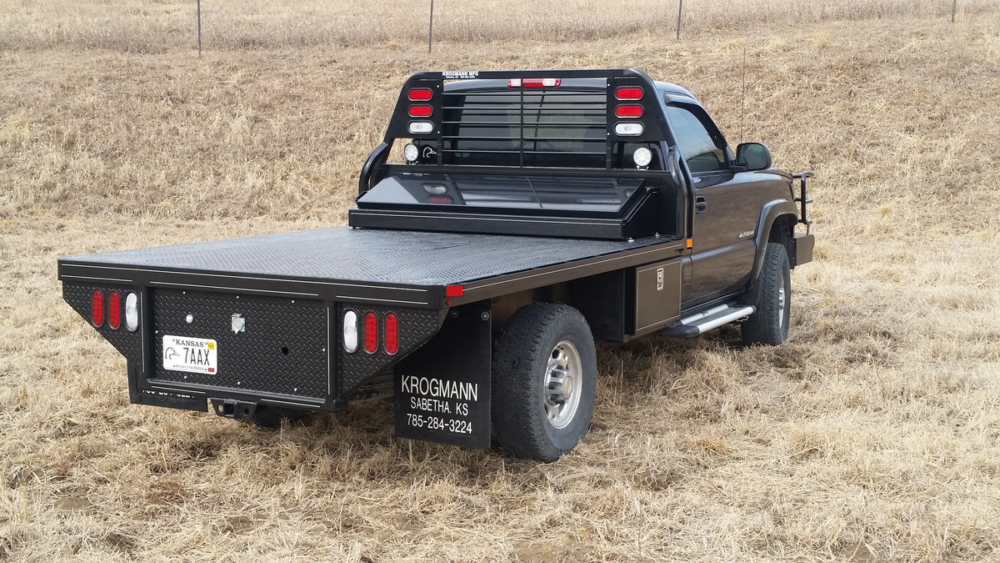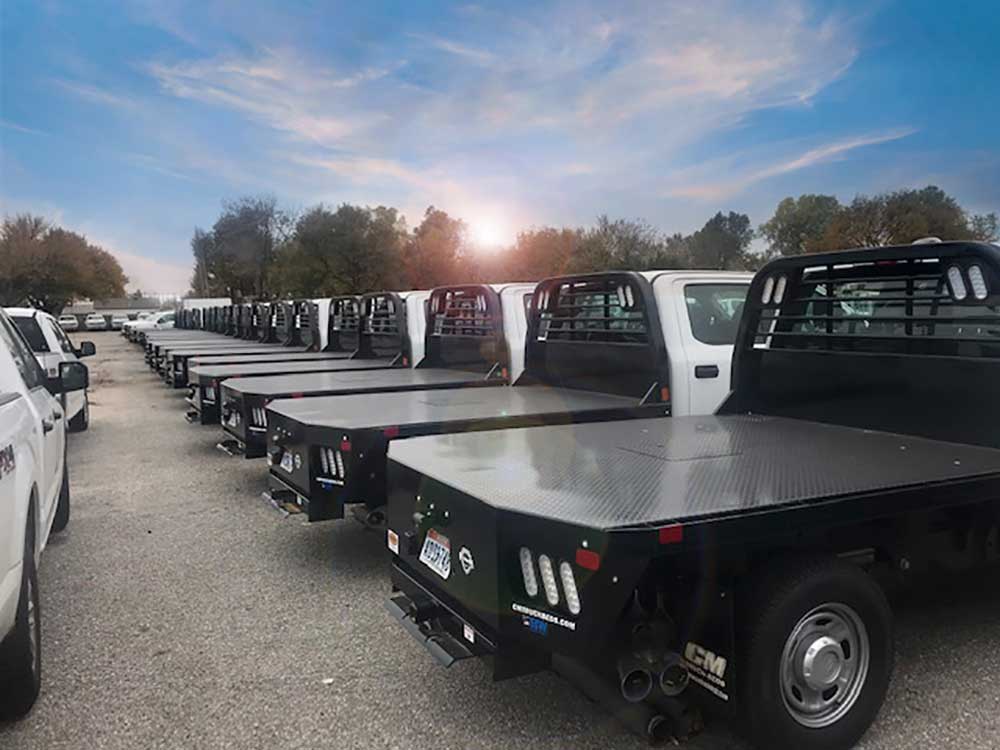A flatbed truck is a vehicle equipped with an open bed used to load and carry various cargo. It has no walls or roof, making it easier for loaders to stack diverse products or materials. Because of this, flatbeds are typically used to transport irregularly shaped cargo that doesn’t fit in conventional trucks.
In case you are wondering, flatbed trucks and flatbed trailers are not the same. The difference between them is that a flatbed truck is a motorized vehicle with the space for cargo built-in, while the flatbed trailer is simply an attachment to the truck; if you want to use a trailer, you’ll need to have a truck for it.
The advantage of trailers is that they can carry heavier and larger loads than ordinary flatbed trucks.

Contents
Flatbed trucks are used for:
- Heavy machinery like tractors and forklifts
- Lumber
- Long pipes
- Formed concrete items
- Wrapped and stackable products
- Shipping containers
How Many Tons Can A Flatbed Truck Carry?
We already addressed this point above for each type of flatbed truck. But the weight a flatbed truck can carry will very much depend on a more relevant question: What are the weight limits of flatbed trucks? The weight limits of flatbed trucks vary from state to state, with the usual maximum gross limit for all flatbeds being 80,000 pounds (40 tons). However, it is important to bear in mind that these limits can be lower than 80,000 pounds in certain areas, and special permits are needed to be allowed to enter those areas.
In order to find the correct weight capacity of a flatbed truck, you need to go through these steps:
- Calculate your truck’s gross vehicle weight rating (GVWR) – This includes passenger, cargo, fuel – i.e., everything in the truck.
- Determine your truck’s curb weight – This means calculating the truck’s weight without the passengers or cargo.
- Find the payload capacity – The payload capacity is basically GVWR minus the curb weight. If your truck’s GVWR is 8,000 pounds and your curb weight is 5,500 pounds, then the weight capacity is 2,500 pounds. No matter what, never surpass the payload capacity, as that’s the exact amount for safe travel.
It might also be helpful to know the weight of different trailers according to their length:
- 30 feet trailers weigh from 7,000 to 7,800 pounds
- 40 feet trailers weigh up to 10,000 pounds
- 48 feet trailers can weigh approximately 13,000 pounds.

Are There Permits For Flatbed Truck Shipping?
Permits for flatbed truck shipping are given to trucks with oversized cargo. With each state having different rules, drivers should get the proper permits in the state they’ll be driving and working in. Three forms of permits can be acquired: 1) divisible and non-divisible loads, 2) overwidth permits, and 3) state overload permits. Make sure to get the necessary ones to avoid any issues.
It must also be noted that flatbed trucking has many more regulations and strict laws in place for safety reasons. Because flatbeds are secured simply by tie-downs, the risk of cargo falling down and causing accidents is much higher.
Flatbed shipping times rely on the drivers’ experience: the shipments arrive much quicker if the driver is skilled and confident. Additionally, because flatbed trucks can carry more cargo, there’s less need to drive back and forth, so the total shipments are done faster.
Types of flatbed trucks
There are several types of flatbed trucks to serve various purposes. Read below as we elaborate on them:
Standard flatbed
This is the basic type of flatbed, consisting of a simple floor unprotected on all sides. It’s astonishingly versatile and the most used type of flatbed, mainly because it can be loaded from any angle you want.
With a standard flatbed, you can have cargo up to 8 feet wide and tall and a maximum weight of 48,000 pounds (24 tons).
Extendable flatbed trucks
Extendable flatbeds are great for longer-than-usual cargo. Although their deck length is about 48 feet, they can be pulled up to 80 feet and carry up to 43,000 pounds (21.5 tons).
These look about the same as standard ones, but they can be extended to carry more freight, usually because a standard flatbed sometimes falls short.
Double drop deck flatbed truck
The double drop deck flatbed is a combination of three decks sitting at different heights off the ground.
These flatbeds can carry taller freight than others – up to 10 feet – because the lower deck is so close to the ground. The front and back ones are much shorter than the middle one, used only for smaller cargo. The maximum weight these trucks can carry is up to 42,000 pounds (21 tons).
Side kit flatbed
Side kit trucks possess side panels and metal spines that can be covered with a tarp and protect weather-sensitive cargo. The panels, spines, and tarp can all be detached from the flatbed and attached again when needed.
These can get up to 53 feet long and carry around 45,000 pounds (22.5 tons) of freight.
Removable gooseneck truck
Removable goosenecks, or RGNs, are versatile trucks used for long and tall cargo. If the gooseneck is detached, it turns into a ramp through which you can load machinery and heavy vehicles.
The RGN can carry loads up to 29 feet long and 42,000 pounds (21 tons).
Benefits of Flatbed Trucks
- Effortless loading and unloading from all sides – As stated earlier, flatbeds don’t have any walls, so loading and unloading can be done from the sides as well as with cranes from high above.
- Durability – Most flatbed trucks are very practical and durable, with low maintenance and easy customization. Due to the openness of flatbeds, cleaning them takes little to no time.
- Versatility – Obviously, having an open truck bed means shipping companies can load whatever they want onto a flatbed, and it will fit. This flexibility gives companies plenty of options and ways to haul freight they wouldn’t otherwise be able to.
- Reduced driving and number of trips – Because you’ll be fitting as much cargo as possible in the increased storage space of a flatbed, you won’t be making unnecessary trips back and forth to complete the delivery. This shortened driving time means faster deliveries, happier customers, and less tired drivers, which is a top priority for all trucking companies. Additionally, less time on the highways means less fuel consumption, so you’ll slowly but surely start to see an increase in savings.
FAQs
We’ll be going over some of the most asked questions about flatbed trucks below.
How much does a flatbed truck cost?
New flatbed trucks cost from $40,000 to $80,000 depending on the type of flatbed you get, the purpose it will fulfill, and the number of features implemented.
Used flatbeds cost from $10,000 up to $30,000, depending on the mileage and condition of the truck.
What is the longest flatbed truck?
While most flatbeds can reach up to 53 feet, extendable flatbeds come with an astounding length of 80 feet.
How will your freight be secured on a flatbed truck?
Although it depends on the style of the flatbed, most freight in these sorts of trucks is tied down using ropes, cords, straps, and chains. These are helpful and necessary to carry cargo on long journeys no matter their shape.
Conclusion
We’ve gone through the most important aspects of flatbed trucks and the different types of trailers, while giving details for all the necessary cargo information a driver needs before starting their tiresome journey. In a world where things need to be distributed all over in as little time as possible, flatbed trucks have been a significant factor and have played a crucial role in raising the standards of shipping.
These simple yet magnificent vehicles have the ability to transport everything, no matter their size, form, or weight, and do so without the hassles other types of trucks go through. This is why they’re one of the most trusted forms of freight transportation and continue to rule the highways. As long as you have the required permits, the world is yours.




